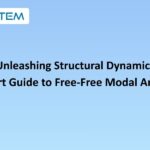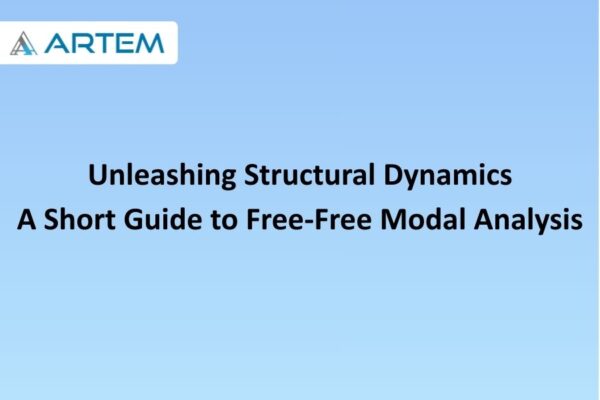Types of Non-linearity
Types of Non-Linearity
Nonlinearity
is natural in physical problems. In fact, the linear assumptions we make are only valid in special circumstances and usually involve some measure of “smallness”, for example, small strains, small displacements, small rotations, small changes in temperature, and so on.
We use linear approximations not because they are more correct but because
- Linear solutions are easier to compute.
The computational cost is smaller.
Solutions can be superposed on each other.
A nonlinear analysis is needed if the loading on a structure causes significant changes in stiffness. Typical reasons for stiffness to change significant are:
⁻ Contact between two bodies
⁻ Strains beyond the elastic limit (plasticity)
⁻ Large deflections, such as with a loaded fishing rod
However, linear analysis is not adequate and nonlinear analysis is necessary when
·Designing high performance components.
·Establishing the causes of failure.
·Simulating true material behavior.
·Trying to gain a better understanding of physical phenomena.
Modern analysis software makes it possible to obtain solutions to nonlinear problems. However, experienced skill is required to determine their validity and these analyses can easily be inappropriate. Care should be taken to specify appropriate model and solution parameters. Understanding the problem, the role played by these parameters and a planned and logical approach will do much to ensure a successful solution.
Generally, linear analysis means that the relationship between the applied force and the response to this force (Ex: displacement) is linear in nature. We know that this displacement can be obtained by inverting the stiffness matrix and then multiplying it with the force vectors. In other words, this means that the stiffness matrix does not change during a linear analysis.
This can be further emphasized by taking the example of a spring with linear and nonlinear characteristics.
As the stiffness is dependent on the displacement, which keeps changing, the initial stiffness matrix cannot be used without continually updating and inverting it during the course of the analysis. This is the reason why nonlinear analysis takes more time to solve compared to a linear FEM analysis.
Mostly, nonlinear analysis depends on the need of the goals i.e., for fatigue, dynamic and so on. A cost-benefit analysis is usually necessary before embarking on the nonlinear analysis of a problem.
There are three major types of non-linearity:
1.Material (plasticity, creep, viscoplasticity/viscoelasticity)
2.Geometric (large deformation, large strains)
3.Boundary These may occur singly or in combination.
Material Non-linearity:
Nonlinear stress-strain relationships are a common cause of nonlinear structural behaviour. Material nonlinearity involves the nonlinear behavior of a material based on a current deformation, deformation history, rate of deformation, temperature, pressure, and so on. Examples of nonlinear material models are large strain (visco) elasto-plasticity and hyper elasticity (rubber and plastic materials) and other types.
Many factors can influence a material’s stress-strain properties, such as:
- 1.Load history (as in elastoplastic response)
- 2.Environmental conditions (such as temperature)
- 3.The amount of time that a load is applied (as in creep response)
Geometric Non-linearity
Geometric nonlinearity arises when the changes in the model’s geometry are very high during the course of deformation. This happens when there are
1.Large deformations
2. Large rotations
3. Both
4. Initial loading conditions before the start of the analysis
Ø If a structure experiences large deformations, its changing geometric configuration can cause the structure to respond nonlinearly
Ø Geometric nonlinearity is characterized by “large” displacements and/or rotations
Ø In linear geometric analysis, the deformations and rotations are smaller like within 5 % as generic rule, but in case of nonlinear geometric analysis, displacement and rotations are large. Small changes in magnitude of force for nonlinear geometry, can change convergence behavior considerably. However the geometric nonlinearity is not only due to large deformation/rotation but varies based loading and situation too.
Ø An example would be the fishing rod
It is difficult to predict the case of geometric nonlinearity, as it needs lot of experiments and judge the case by looking the scenario. In FEA software geometry nonlinear is solved simply by keeping nonlinear zone on.
In analyses involving geometric nonlinearity, changes in geometry as the structure deforms are considered in formulating the constitutive and equilibrium equations. Many engineering applications such as metal forming, tire analysis, and medical device analysis require the use of large deformation analysis based on geometric nonlinearity. Small deformation analysis based on geometric nonlinearity is required for some
applications, like analysis involving cables, arches and shells.
Contact non-linearity:
Ø When two separate surfaces touch each other such that they become mutually tangent, they are said to be in Contact. In contact
nonlinearity abrupt change in stiffness may occur when bodies come into or out of contact each other. This type on nonlinearity is used to simulate the gap between two parts.
In the common physical sense, surfaces that are in contact have below characteristics:
ü They do not interpenetrate
ü They can transmit compressive normal forces and tangential friction
forces
ü They often do not transmit tensile normal forces
ü They are therefore free to separate and move away from each other
Nonlinear FEA Issues:
- Achieving convergence: Obtaining convergence is biggest challenge in nonlinear analysis.
·Trial and error is sometimes required.
·Complex problems might require more load increments, and many iterations at the each load step to achieve the convergence.
- Balancing expenses versus accuracy
·FEA involves expenses (Solution time, disk and memory requirements)
·More detail and a finer mesh generally lead to a more accurate solution, but require more time and system resources.
·Nonlinear analysis need additional iteration affects both accuracy and expenses.
- Verification
· Difficult to verify the FEA results due to increased complexity of nonlinear behaviour.
· The sensitivity studies (mesh convergence, increased mesh density, reduced load increments, varying other model parameters) become more expensive.
- Results of the nonlinear analysis cannot be scaled. The structural behavior can be markedly non-proportional to the applied load.



